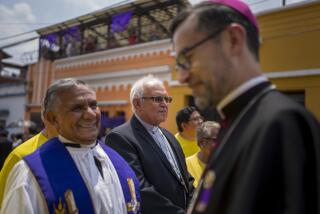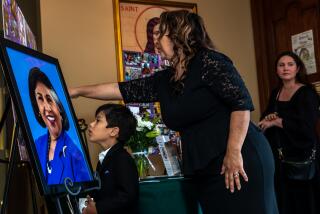Mother Teresa’s Illness Casts Pall Over Followers : In Calcutta, Prayers--and Gloom
CALCUTTA — For the last two weeks, the Sisters of Charity have been praying in shifts on the second floor of the House for the Dying and Destitute, chanting the rosary and singing “Ave Maria” into the night.
On the floor below, other nuns, clad in simple white saris, have continued their work alongside volunteers from the United States, Europe and Asia, going from cot to cot tending to dozens of living skeletons, as they have for decades.
But there is a sadness in the air these days in the decaying old building in the heart of Calcutta’s slums, a fear that the woman who started what many believe is the most selfless crusade in modern history may soon be gone.
Her portrait hangs in a corner of the room where Calcutta’s poorest can now die with dignity, near a sign that spells out her life’s dream: “The greatest aim of human life is to die in peace with God.”
Failing Health
The message is signed by Mother Teresa, and although none of the nuns will even discuss it, it is the failing health of their Mother Superior that has brought such gloom to the city where she began her Missionaries of Charity movement nearly 40 years ago.
The vigil has not been confined to Mother Teresa’s mission, or to her modern headquarters building. Since the 79-year-old Yugoslav-born nun was admitted to a nursing home with heart problems Sept. 5, her seesaw struggle to live has spread concern throughout the city, touching everyone from the street people to whom she has dedicated her life to the most senior government officials.
Bulletins on the state of her health are flashed on state television and carried in all the national newspapers. Last week, Prime Minister Rajiv Gandhi flew to Calcutta with his wife to pay a 10-minute visit to the woman whom many regard as a living saint.
So strong is the concern that a state official held a news conference Sunday to criticize the officials who have been visiting Mother Teresa in the intensive-care unit of Woodland’s Nursing Home, situated in Calcutta’s most affluent neighborhood.
“Who knows what infections even these officials may be carrying with them,” said H. A. Halim, Speaker of the state legislature of West Bengal state.
There have been conflicting reports about Mother Teresa’s condition, and this has contributed to the uncertainty about her.
On Sunday and Monday, the bulletins seemed favorable. “Mother’s fever is nearly gone,” the Monday bulletin said, suggesting that her condition had improved. But a morning newspaper carried a headline saying, “Mother Teresa Not Out of Danger.”
One bulletin, reported by telephone, indicated that her condition had deteriorated because she was receiving what was recorded as “heart massage.” In fact, the bulletin had said “cardiac message,” and it referred to the impulses from a pacemaker that had been installed days before.
The absence of clear medical information has spawned rumors, including death scares, reports of a power struggle within the Missionaries of Charity and often-reported but unconfirmed criticism that the nursing home was responsible for Mother Teresa’s persistent fever because the pacemaker installed by its doctors was infected.
The rumors have endured in part because Mother Teresa is not strong enough to meet with the press. Sister Priscilla, who has been designated the order’s spokeswoman on the subject, has grown weary of the constant demand for news.
“Not more newsmen,” she said with a sigh Sunday night as three Western journalists paid a call on the mission’s headquarters during evening prayers. Nevertheless, she said she had visited Mother Teresa that afternoon and that “she hopes to come home soon.”
Asked if she believed that Mother Teresa would actually return soon, Sister Priscilla said: “I don’t know, but we all pray that she may come back as soon as possible. We all miss her.”
She appeared to be on the verge of tears.
Halfway across town, at Mother Teresa’s hospice for the destitute, there seemed to be little time for rumors or speculation.
It was here that Mother Teresa opened her home in 1948, 19 years after she came to Calcutta as a convent teacher with the Loreto order of Ireland. And it was here that she built an international organization that now includes 335 orphanages, hospices, refugee centers, clinics, AIDS centers and homes for the destitute in 66 countries on five continents.
At the entrance to the Calcutta hospice is a sign that says, “Welcome to Mother’s First Love, Home for the Destitute and Dying.”
One of the nuns, who agreed to talk with a reporter Monday on the condition that her name not be used, said Mother Teresa came to the hospice often when she was well, even though she maintains 151 other homes in India.
She conceded that the mood has changed here since the Mother Superior was hospitalized.
“Everyone here is very sad,” she said. “Yes, we are worried, and always there is someone upstairs, praying for Mother’s recovery.”
In the huge hospice room, moving constantly among the green cots occupied by “pavement dwellers” waiting for death or a miracle, were a dozen of the foreign volunteers who are always here. Two years ago, former California Gov. Edmund G. Brown Jr. worked here for several weeks. Tourists and other travelers often stop for a few days or weeks to lend a hand.
Attracts Everyone
Andy Wimmer, a former West German banker, is one of many repeat visitors. Wimmer, who has spent a total of a year and a half at the home since 1985, is closer than most to the home and its creator.
“The great power of Mother Teresa,” he said, “is that she is not only the mother of the poor--even the rich are attracted by her ideas.”
It is in this universal attraction, Wimmer said, that he senses the greatest potential impact if Mother Teresa does not recover.
“Sometimes, I think that less money would come into the mission if Mother is not around,” he said. “She is a very charismatic figure, and probably none of the other sisters could match that.”
But otherwise, he said, little would change in the Missionaries of Charity if its founder were gone.
“The order is well-established now,” he said. “The life and the work will not be disrupted.”
More to Read
Sign up for Essential California
The most important California stories and recommendations in your inbox every morning.
You may occasionally receive promotional content from the Los Angeles Times.










